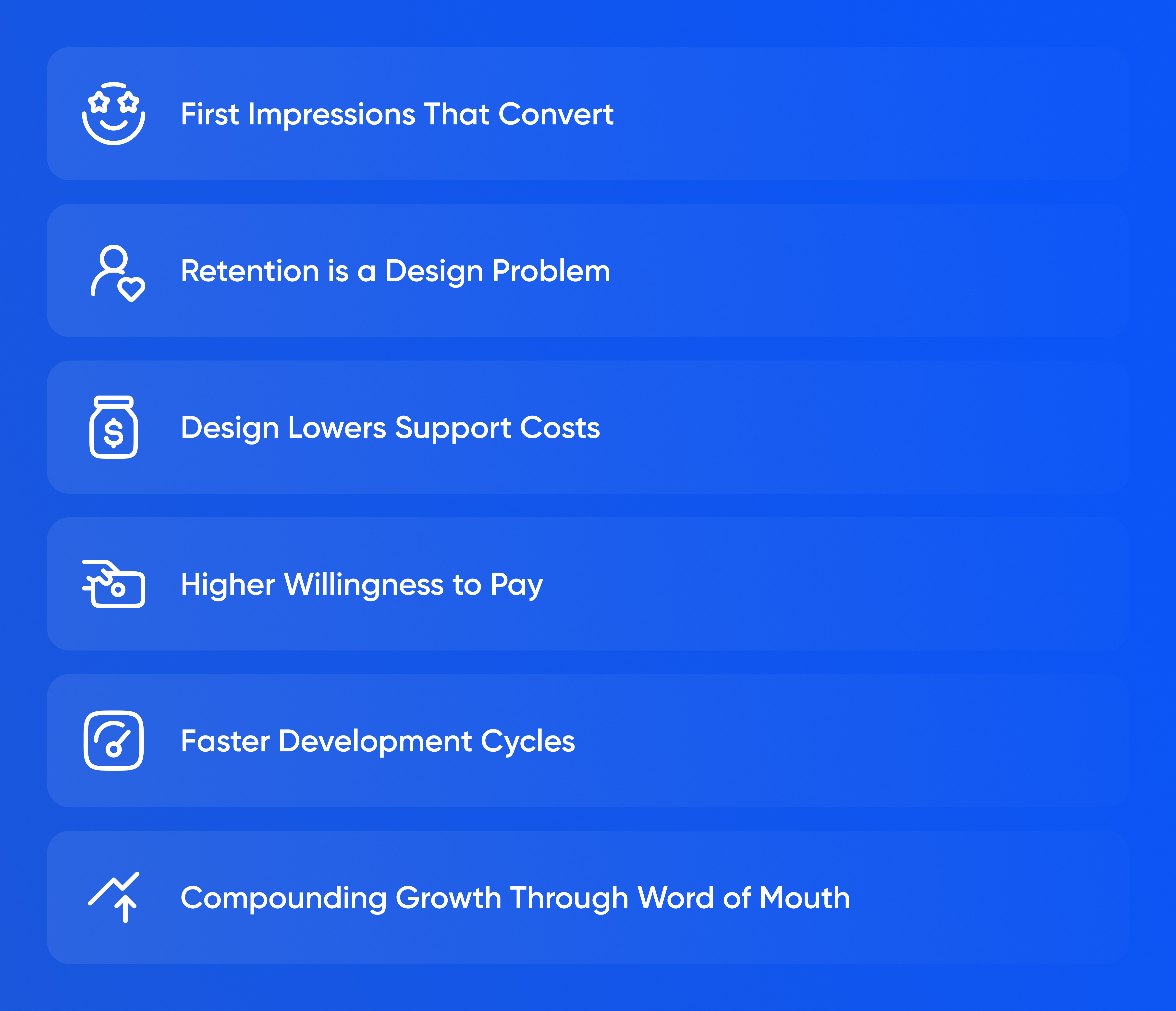For early-stage startups, every dollar counts. Founders obsess over customer acquisition costs, lifetime value, burn rate, and fundraising timelines. But there’s one investment that consistently delivers massive returns and is still underestimated by many teams: user experience design.
Good design is not just an aesthetic upgrade. It’s not about making things look sleek or trendy. It’s a force multiplier — one that accelerates adoption, deepens retention, builds trust, and turns users into advocates. In fact, some of the most financially successful digital products in history owe their scale not to flashy marketing or unique technology, but to design that simply made people want to come back.
The return on investment in UX is real, measurable, and often dramatic. Let’s explore how.

First Impressions That Convert
Whether you're launching an MVP or scaling a feature-rich SaaS platform, your first impression is your only guaranteed shot. Users will judge your product within seconds of opening it. A clunky layout, confusing navigation, or lack of responsiveness immediately signals risk. Even if your idea is strong, poor UI/UX makes users hesitant to trust it.
On the other hand, a well-designed interface conveys professionalism and competence. It reassures users that their time and data are in good hands. In practical terms, this means higher sign-up completion rates, lower bounce rates, and stronger early adoption — all of which lead to faster product validation and a better shot at investor interest.
We’ve seen this play out over and over at Movadex. In one case, redesigning just the onboarding flow of a healthcare platform increased the signup rate by 47%. The functionality didn’t change — but the way users felt while using it did.
Retention is a Design Problem
Acquiring users is expensive. Retaining them is profitable. And retention, in many cases, comes down to how the product makes users feel day after day.
Poor UX leads to frustration, which leads to churn. Buttons that don’t behave predictably. Screens that are visually dense or unclear. Flows that require five steps when two would do. These small annoyances build up until users silently walk away — often without saying a word.
Great design anticipates user needs. It creates interfaces that feel effortless. It simplifies tasks, reduces friction, and removes confusion. And when done well, it doesn’t just keep users around — it makes them advocates.
The best retention strategy isn’t another push notification. It’s building a product experience people actually enjoy using.
Design Lowers Support Costs
When users can’t figure something out, they contact support — or they quit. In both cases, that’s a cost. One eats into your operational resources. The other eats into your growth.
Thoughtful design reduces the burden on customer support teams. Clear information architecture, intuitive flows, helpful tooltips, and self-service elements empower users to solve their own problems.
Even small UI updates can dramatically reduce inbound support tickets. One Movadex client saw a 32% drop in “How do I...?” support queries after a series of design tweaks to their dashboard. That translated into not only happier users, but saved hours of staff time each week.
Design is proactive support — and it scales beautifully.
Higher Willingness to Pay
Whether you’re targeting consumers or enterprises, buyers equate good design with quality. If a product feels clunky or outdated, customers assume the entire experience — including performance, reliability, and support — will be similarly underwhelming. That directly affects pricing.
Conversely, when a product is well-designed, users are more likely to perceive it as premium. That creates space for higher pricing, more upsells, and greater long-term value.
This isn’t just theory. Companies like Notion, Figma, and Linear charge more than their competitors not because of radically different functionality — but because their design invites trust, clarity, and delight.
In many ways, great design pays for itself in pricing power alone.
Faster Development Cycles
It might sound counterintuitive, but investing in UX design actually speeds up development.
Without clear, thoughtful design, development teams waste time interpreting specs, rewriting poor flows, and handling rework from confused users. With a strong UX foundation, developers work with greater precision and fewer errors. Design systems also promote consistency, making it easier to scale and iterate.
At Movadex, we’ve seen teams ship weeks faster simply because they had better handoffs between design and development. No ambiguity. No guesswork. Just clear, validated, and user-tested flows that engineers can build without roadblocks.
Speed is critical in startup life — and design helps deliver it.
Compounding Growth Through Word of Mouth
No one shares a product they struggled to use. But people love to talk about experiences that surprise them — the ones that made a mundane task feel seamless, or that felt intuitive in a way they didn’t expect.
Good design spreads. It becomes a talking point in founder communities, Slack groups, and user forums. It turns into screenshots in tweets. It becomes part of your brand.
When users feel proud of using your product — when they enjoy the experience — they become your most powerful marketing channel. And unlike paid ads, that kind of growth compounds with time.
Final Thought: Design Is the Smartest Spend
Startups often think design is something to “add later” — after traction, after funding, after scale. But the startups that win are the ones who treat design as a growth engine from day one.
It’s not a luxury. It’s a multiplier. It improves every metric that matters: conversions, retention, support costs, development speed, pricing power, and customer advocacy.
At Movadex, we’ve seen how great design transforms not just products, but entire businesses. We believe in design that earns its keep — and then some.
If you’re serious about growth, start by investing where it matters most: in how your users experience what you’ve built.




